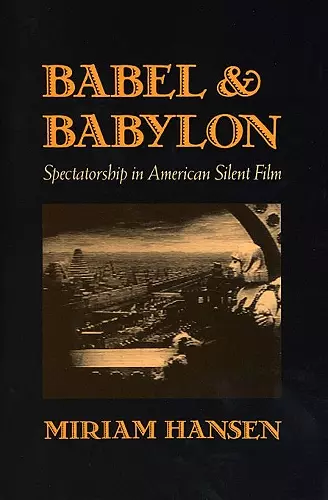Babel and Babylon
Spectatorship in American Silent Film
Format:Paperback
Publisher:Harvard University Press
Published:14th Apr '94
Currently unavailable, and unfortunately no date known when it will be back

A brilliant study of silent cinema, characterized by meticulous historical scholarship and rigorous and illuminating textual analyses...A work of the first importance in the wider debates about the nature of cultural production and consumption and about texts and reception...This book is a model of what cultural studies ought to be. -- Richard Dyer University of Warwick
Focusing on exemplary moments in the American silent era, Hansen explains how the concept of the spectator evolved as a crucial part of the classical Hollywood paradigm—as one of the new industry’s strategies to integrate ethnically, socially, and sexually differentiated audiences in a modern culture of consumption.
Although cinema was invented in the mid-1890s, it was a decade more before the concept of a “film spectator” emerged. As the cinema began to separate itself from the commercial entertainments in whose context films initially had been shown—vaudeville, dime museums, fairgrounds—a particular concept of its spectator was developed on the level of film style, as a means of predicting the reception of films on a mass scale. In Babel and Babylon, Miriam Hansen offers an original perspective on American film by tying the emergence of spectatorship to the historical transformation of the public sphere.
Hansen builds a critical framework for understanding the cultural formation of spectatorship, drawing on the Frankfurt School’s debates on mass culture and the public sphere. Focusing on exemplary moments in the American silent era, she explains how the concept of the spectator evolved as a crucial part of the classical Hollywood paradigm—as one of the new industry’s strategies to integrate ethnically, socially, and sexually differentiated audiences into a modern culture of consumption. In this process, Hansen argues, the cinema might also have provided the conditions of an alternative public sphere for particular social groups, such as recent immigrants and women, by furnishing an intersubjective context in which they could recognize fragments of their own experience.
After tracing the emergence of spectatorship as an institution, Hansen pursues the question of reception through detailed readings of a single film, D. W. Griffith’s Intolerance (1916), and of the cult surrounding a single star, Rudolph Valentino. In each case the classical construction of spectatorship is complicated by factors of gender and sexuality, crystallizing around the fear and desire of the female consumer.
Babel and Babylon recasts the debate on early American cinema—and by implication on American film as a whole. It is a model study in the field of cinema studies, mediating the concerns of recent film theory with those of recent film history.
Babel and Babylon is a far-reaching book that leads us to new questions about history and theory. It amply proves that early cinema can be one of the most intriguing and productive domains of film study today. -- Dana Polan * Film Criticism *
Hansen’s expansive, detailed, and exceptionally erudite study assesses key instances when cinema spectatorship opened up the possibility of articulating the contradictions of female experience. -- Constance Balides * Signs *
A bold and strikingly original exploration… Hansen has produced a work that has revolutionized the concept of spectatorship in American silent film and that will be an essential tool for historians and film scholars alike. -- Leslie Fishbein * American Historical Review *
An innovative look at the role and impact of class and gender, Hansen’s work significantly realigns many of the issues that have traditionally dominated the study of American silent film. -- Edward D. C. Campbell, Jr. * Journal of American History *
A brilliant study of silent cinema, characterized by meticulous historical scholarship and rigorous and illuminating textual analyses… A work of the first importance in the wider debates about the nature of cultural production and consumption and about texts and reception… This book is a model of what cultural studies ought to be. -- Richard Dyer, University of Warwick
ISBN: 9780674058316
Dimensions: unknown
Weight: 562g
390 pages